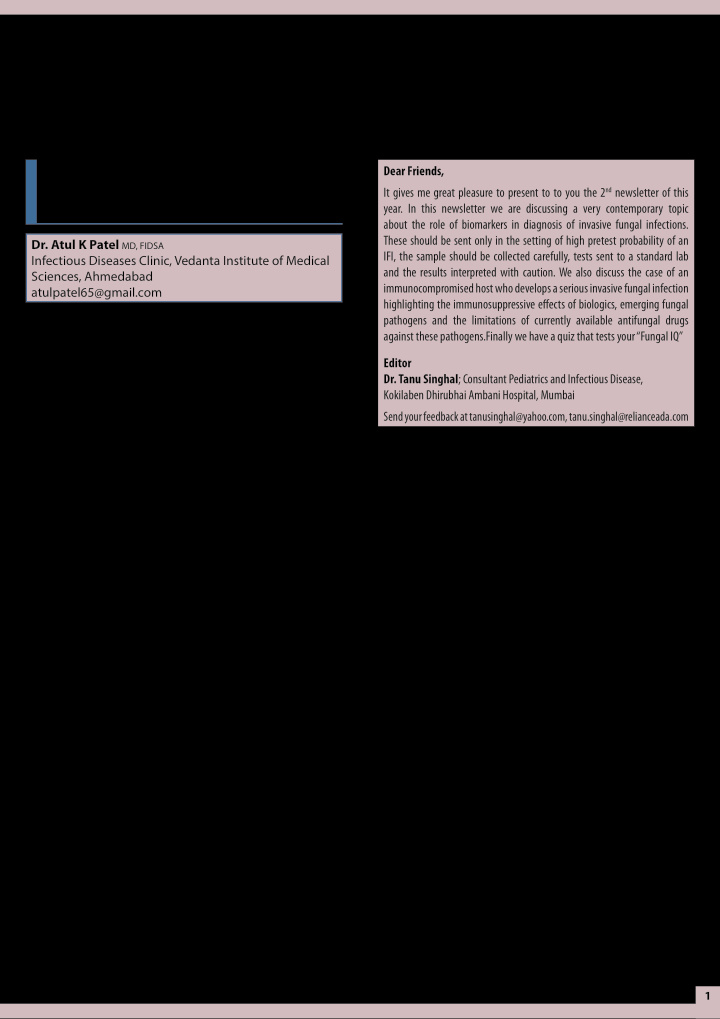



Fungal Infections Study Forum www.fjsftrust.org Volume 2, Issue 2 An unusuAl cAuse of lung Abscess Dear Friends, in A pAtient receiving biologics It gives me great pleasure to present to to you the 2 nd newsletter of this & immunosuppressive drugs for year. In this newsletter we are discussing a very contemporary topic Ankylosing spondylitis about the role of biomarkers in diagnosis of invasive fungal infections. These should be sent only in the setting of high pretest probability of an Dr. Atul K Patel MD, FIDSA IFI, the sample should be collected carefully, tests sent to a standard lab Infectious Diseases Clinic, Vedanta Institute of Medical and the results interpreted with caution. We also discuss the case of an Sciences, Ahmedabad immunocompromised host who develops a serious invasive fungal infection atulpatel65@gmail.com highlighting the immunosuppressive effects of biologics, emerging fungal Introduction pathogens and the limitations of currently available antifungal drugs The use of biological agents to treat inflammatory conditions and malignancies against these pathogens.Finally we have a quiz that tests your “Fungal IQ” has remarkably increased over the past decade. However, biologic use can be Editor associated with serious life threatening infectious complications. Duration of Dr. Tanu Singhal ; Consultant Pediatrics and Infectious Disease, therapy on biologics determines the severity of immunosuppression. Generally Kokilaben Dhirubhai Ambani Hospital, Mumbai it takes several months after starting biologics to produce lymphocytopenia and again several months for immune function to recover after stopping Send your feedback at tanusinghal@yahoo.com, tanu.singhal@relianceada.com therapy. Mycobacterial infections, varicella infection and invasive fungal were non reactive. 2D ECHO showed rheumatic heart disease, mild mitral infections (IFI) are common infectious complications associated with TNF alpha stenosis, mild MR, PML mobility mildly restricted, normal EF, no PAH. USG inhibitors. This communication describes an invasive fungal infection due to abdomen showed oedematous terminal ileum/ ileocaecal junction/appendix, an emerging fungal pathogen in a patient on biologics. caecum and proximal ascending colon with max thickness of 4.2 mm with few regional mesenteric lymph nodes, largest 10X6 mm without necrosis or Case Report conglomeration. A 40 years old male who had history of acute rheumatic fever in childhood, was diagnosed to have Ankylosing Spondylitis (AS) in 2011. Since then he was on CT thorax showed thick walled cavitatory lesion in middle and lower lobes regular follow up with a rheumatologist for AS. He was initially treated with of the right lung (Figure 1). Sputum was sent multiple times for direct NSAIDs and steroids. He required methyl prednisolone pulses intermittently microscopy. One of them showed 24-28 pus cells per L.P.F, few GPC in pairs due to disease flares. He had also received multiple biologics including and GNBs with occasional fungal hyphae with negative culture. BAL direct infliximab (5 doses in 2014), etanercept (2 doses in 2014) and adalimumab microscopy, cytology and GenXpert for MTB/Rif were negative. BAL culture was (2 doses in February 2015). He was also receiving 7.5 mg Methotrexate once negative for TB, fungal and bacterial pathogens. Post bronchoscopy sputum a week for last 2 years and recently was also prescribed prednisolone 10 mg showed fungal hyphae on direct microscopy and culture grew mycelial fungus, once a day. He was diagnosed to have Diabetes in January 2015 for which he subsequently identified as Paecilomyces species (Figure 2). Transbronchial was started on metformin with HbA1C of 8.7. He was admitted to Sterling biopsy was reported as bronchiolitis obliterans organizing pneumonia (BOOP) Hospital in February 2015 with bilateral multiple joint pains (small and large), with no evidence of fungal/mycobacterial infection in examined sample. abdominal discomfort, diarrhea alternating with constipation and dry cough, all for 10 days. Work up showed inflammatory bowel disease and was started Patient was started on Voriconazole. He was readmitted after three weeks with on Mesalamine sachet 2 gm twice daily and was also advised 2 doses of increased cough and sputum, intermittent high-grade fever and gradually Adalimumab 2 weeks apart. progressive breathlessness. Repeat HRCT thorax showed increase in the extent of thick walled cavitatory lesion involving even right upper lobe compared He was readmitted at Sterling Hospital after two weeks with complaints of to previous HRCT thorax. He was started on Liposomal amphotericin B and cough with yellow copious sputum, fever and breathlessness. His laboratory voriconazole was continued. The patient was subsequently transferred to work up showed Hb- 8.8 gm%, WBC of 17000/ µl, DLC of 63/30/01/03/0, another hospital near his residence for further continuation of treatment. platelets of 397000/ µl and ESR 86 mm/hour. Biochemistry and electrolytes Thereafter he was lost to follow up. were within normal limits. CRP was 12 times upper level of normal. HIV/HBsAg Fig. 1: CT scan Thorax showing thick walled cavitatory lesion in Rt middle and Fig. 2: LCB mount from isolate showing fungal hyphae lower lobe 1
Recommend
More recommend